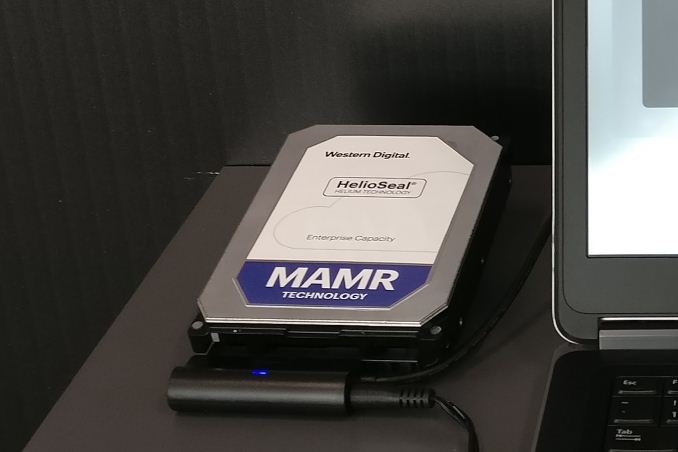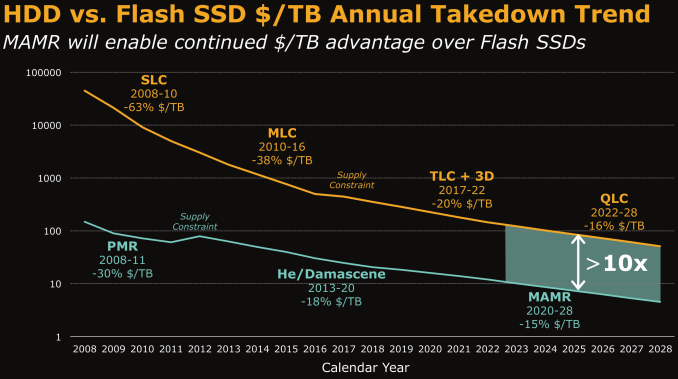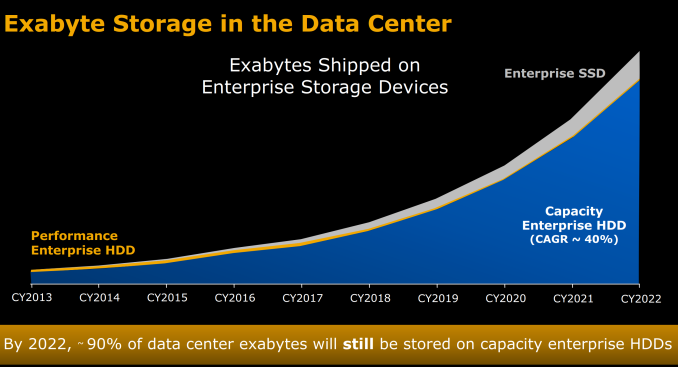Western Digital Stuns Storage Industry with MAMR Breakthrough for Next-Gen HDDs
by Ganesh T S on October 12, 2017 8:00 AM EST
Yesterday, Western Digital announced a breakthrough in microwave-assisted magnetic recording (MAMR) that completely took the storage industry by surprise. The takeaway was that Western Digital would be using MAMR instead of HAMR for driving up hard drive capacities over the next decade. Before going into the specifics, it is beneficial to have some background on the motivation behind MAMR.
Hard drives may be on the way out for client computing systems, but, they will continue to be the storage media of choice for datacenters. The Storage Networking Industry Association has the best resources for identifying trends in the hard drive industry. As recently as last year, heat-assisted magnetic recording (HAMR) was expected to be the technology update responsible for increasing hard drive capacities.

Slide Courtesy: Dr.Ed Grochowski's SNIA 2016 Storage Developer Conference Presentation
'The Magnetic Hard Disk Drive: Today’s Technical Status and Its Future' (Video, PDF)
Mechanical Hard Drives are Here to Stay
One of the common misconceptions amongst readers focused on consumer technology relates to flash / SSDs rendering HDDs obsolete. While using SSDs over HDDs is definitely true in the client computing ecosystem, it is different for bulk storage. Bulk storage in the data center, as well as the consumer market, will continue to rely on mechanical hard drives for the foreseeable future.
The main reason lies in the 'Cost per GB' metric.
Home consumers are currently looking at drives to hold 10 TB+ of data, while datacenters are looking to optimize their 'Total Cost of Ownership' (TCO) by cramming as many petabytes as possible in a single rack. This is particularly prevalant for cold storage and archival purposes, but can also expand to content delivery networks. Western Digital had a couple of slides in their launch presentation yesterday that point towards hard drives continuing to enjoy this advantage, thanks to MAMR being cost-effective.
Despite new HDD technology, advancements in solid state memory technology are running at a faster pace. As a result SSD technology and NAND Flash have ensured that performance enterprise HDDs will make up only a very minor part of the total storage capacity each year in the enterprise segment.
The projections presented by any vendor's internal research team always need to be taken with a grain of salt, but given that SanDisk is now a part of Western Digital the above market share numbers for different storage types seem entirely plausible.
In the next section, we take a look at advancements in hard drive technology over the last couple of decades. This will provide further technical context to the MAMR announcement from Western Digital.












127 Comments
View All Comments
MajGenRelativity - Thursday, October 12, 2017 - link
Western Digital stated their intention to produce higher capacity drivesmadwolfa - Thursday, October 12, 2017 - link
Because this is what enterprise market is interested in.MajGenRelativity - Thursday, October 12, 2017 - link
Exactly. That's the whole point of HAMR, MAMR, and all those other acronyms. If WD wasn't going to increase capacity, then they would just fire their entire R&D departmentdbrons - Thursday, October 12, 2017 - link
yes, interesting and good news.Says drives avail 2019romrunning - Thursday, October 12, 2017 - link
I really hope this means that SMR will be dumped now that a much better storage technology is available. SMR = slower speed & more error check/correction for reliability, all for just a small increase in storage density over PMR. I really hope it dies out.DanNeely - Thursday, October 12, 2017 - link
In the consumer world I agree, its surprise behavior among people who expect something normal is sketchy enough that it's not worth the extra 20% it gives.For enterprise though, there'll always be data center customers who're quite willing to make the tradeoff to store archival//backup/write only data.
This is what the article says WD is currently doing no consumer model; but if you own a data center and want HDDs by the shipping container (or some other massive quantity) they'll hook you up.
romrunning - Thursday, October 12, 2017 - link
Hopefully MAMR completely takes over. I'd like to see BackBlaze get them as soon as possible so that we can see their reliability rates against other PMR/SMR drives.mikato - Thursday, October 12, 2017 - link
"Despite new HDD technology, advancements in solid state memory technology are running at a faster pace. As a result SSD technology and NAND Flash have ensured that performance enterprise HDDs will make up only a very minor part of the total storage capacity each year in the enterprise segment."What? Am I missing something? Those sentences mesh with each other, but disagree with both graphs shown. HDDs are almost always more capacity and the graph shows they are 10x less $/TB. It would be tough for SSDs to have far surpassed HDDs in annual storage capacity in enterprise applications.
mikato - Thursday, October 12, 2017 - link
Hmm, well now I see the "performance" vs "capacity" enterprise HDD distinction in the second graph. Wow, that came out of nowhere. There was nothing in the text that indicated you were breaking HDDs into 2 segments up to that point. I would definitely recommend clarifying that.melgross - Thursday, October 12, 2017 - link
It's obviously wrong.